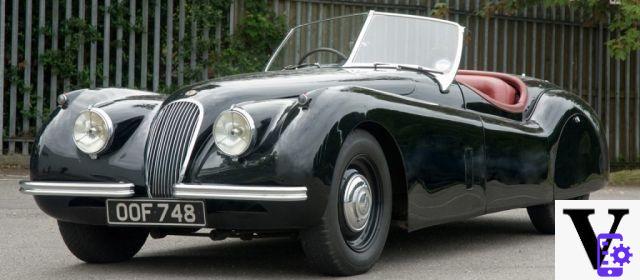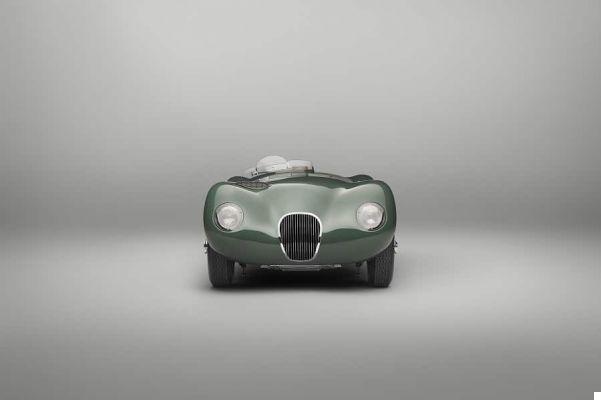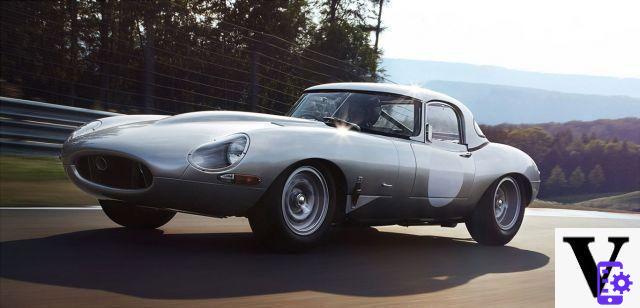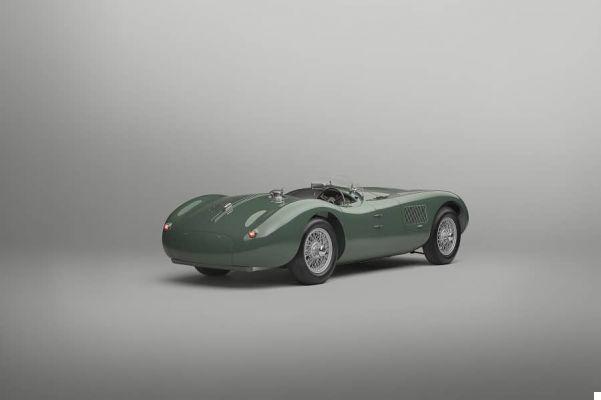There are cars that represent one milestone in the history of a house, and for Jaguar that honor belongs to Jaguar C-Type. The legendary British racing car turns 70 this year, and to celebrate this very special birthday Jaguar through its section dedicated to historic cars, Jaguar Classic, brings the legend back to life. They will indeed be rebuilt of the new Jaguar C-Type Continuation in very limited numbers, made entirely by hand, following the specifications of the 50s. Let's find out the history of this model and its secrets together.
Jaguar C-Type, the jaguar that made the house legendary
For many manufacturers, there is a moment that defines a before and an after, the beginning of a myth after years of “apprenticeship”. For Jaguar this moment is the birth of C-Type. But let's take a small step back. The English house founded by William Lions in fact, after decades of building Sidecars as the "Swallow Sidecar Company" and then cars with the name SS Cars, made its mark in the world in 1948, with the birth of the exceptional Jaguar XK120.
This car was born as "show car“, That is car to show an important novelty of Jaguar, namely the XK engine, from which the car also takes its name. This is one of the longest-lived and most flexible engines ever, capable of serving luxury sedans such as Mk2 or racing cars, as we will see recently. However, the car liked it so much that it went into production, and began to set records. Jaguar XK120 she is beautiful, so much so that she was chosen by world actors and stars, and hers 3.4 six-cylinder in-line engine with 162 hp made it the fastest production car in the world with 219,830 km / h.

Jaguar XK120 also began to win on the track, thanks to perfect driving and its reliable and powerful engine, capable of exceeding 200 HP. From these early successes, Sir William Lions and his staff came up with an idea. To produce an unbeatable racing car, capable of winning the 24 Hours of Le Mans. The real problem was being able to fight against the unbeatable Ferrari, capable of creating more powerful engines than all the rivals. Jaguar then decided to develop a V12 starting from the 6-cylinder XK6, but with disappointing results. The Coventry Racing Team then turned to two revolutionary concepts: lightness and aerodynamics.

Thus was born C-Type: a car light, very light, based on the XK120 but able to save on the scale compared to this one over 400 kg. The aerodynamic care then it made her able to slice through the air like no other. The engine was the almost road version of the Jaguar XK 3.4. It was an engine that it was not designed to run, designed for luxury and fast cars, but which thanks to its compact size was much lighter than Ferrari V12s, and left room for the aerodynamic care by Jaguar technicians. It was then reliable and fairly powerful with its 200 CV, and at the end of the Mulsanne / Hunadièeres straight capable of pushing C-Type up to over 240 km / h.
The victory of 1951 and the debut of disc brakes
Jaguar's first participation in the 24 Hours of Le Mans came in 1951, where the first version of C-Type he won with 9 laps ahead on the pursuing Talbot. Think its official name was Jaguar XK120-C, a clear sign of the derived from the road sports car of the Jaguar. The pilots Peter Walker and Peter Whitehead therefore managed to defeat the most powerful and fastest rivals with aerodynamics and lightness, triumphing on the Circuit de la Sarthe. But for Jaguar one victory was not enough.

Indeed, Jaguar had in his pocket an innovation that has forever changed the world of motors. After a disappointing 24 Hours of Le Mans in 1952, which ended with no cars reaching the finish line, Jaguar realized that something was still missing from his C-Type. Lightness and aerodynamics were no longer enough, but the XK engines if "squeezed" still became grumpy and much less reliable. Where to improve again? In a fundamental forgotten by all the others: braking.
In fact, in 1952 all the cars participating in Le Mans had drum brakes, simple and cheap to make but not very efficient, and subject to frequent overheating. Jaguar then together with the English Dunlop developed a system that had been looking for its final form for decades: disc brakes.

With these brakes, the Jaguar C-Type could brake much later on the straights, braking was smooth throughout the stroke, and could outrun rivals effortlessly. A revolution that made small cars green unbeatable in the 24 1953 Hours of Le Mans, where Jaguar took first, second and fourth places.
After these two victories in three years, Jaguar C-Type became legend, and set the stone for the next 3 wins for its replacement, the D-Type, which brought Jaguar's booty to 5 wins in 7 years.
The rebirth of the Jaguar C-Type Continuation: 8 examples hand-built by Jaguar Classic
We are therefore talking about a legendary car, which earned Jaguar a place in the Olympus of the best car manufacturers in the world. They were built in total 53 examples of C-Type, and today Jaguar with its division Jaguar Classic has decided to do restart the production of another 8 units.

In fact, we are not talking about 8 restorations of existing cars, but just about one resumption of production of the legendary C-Type. This is just the latest car to join the program Jaguar Classic Continuation. In fact, in 2015 the Coventry House decided to resume the production of 6 examples of Jaguar E-Type Lightweight. The racing version of the equally legendary British coupe had been lost in a terrible fire at the Coventry factory in the years of its production.

From the experience gained from decades of production, Jaguar built 6 totally handcrafted E-Type Lightweights from scratch, using techniques of the time and without modernizing any component. The only "poetic license" was the use of modern high-strength steels, which lowered the weight by 114 kg compared to the original of the 60s.

After E-Type Lightweight, the Jaguar Classic Continuation has resumed production of a very limited number of XKSS and D-Types, and today it's the turn of the legendary C-Type. All new C-Type Continuation will be built from scratch starting with the trellis frame, passing through the XK engine and the bodywork. These little masterpieces will be handmade by skilled craftsmen in the dedicated plant Jaguar Land Rover Classic Works di Coventry.
The incredible research and restoration of Jaguar C-Type Continuation components
If then the mechanics will remain unchanged from 70 years ago, let's take a look at what the beautiful lines of the Jaguar C-Type will hide. The specifications taken as the "basis" for the construction of the "new" Jaguar C-Type are those of model that dominated the 24 1953 Hours of Le Mans. We are therefore talking about the first European racing car with disc brakes, which also in 2021 will be made with the techniques of the time and not modernized. To be able to rebuild and replicate all the parts that make up the Jaguar C-Type Continuation, the Jaguar Classic division has created a 3D CAD model, used for the first time by one of their projects. Furthermore, all the original drawings from the 50s have been used, analyzed and revised, in search of the most complete adherence to the original project.

In Jaguar there was a vit was a treasure hunt to be able to create the C-Type Continuation according to the original drawings. But it was not only problematic to be able to replicate the chassis, engine, brakes and suspension. The real challenge was find all original components, the original interior details, reconditioned or even found new from Jaguar Classic. Let's give you an example: Jaguar Classic has struggled a lot to find the original Lucas rearview mirrors. The Jaguar Classic guys only managed to find one, but somehow they managed to find enough original parts to be able to guarantee every C-Type Continuation an original rearview mirror.

The interiors, the instruments, the windshield and the internal clocks, fundamental in 1953 to measure one's progress, they were restored, rebuilt and refurbished for Jaguar C-Type Continuation by master craftsmen, as well as even the switch for the ignition has been made with the same specifications as the original. The work developed on the tachometer. This fundamental instrument, in fact, is unique to the C-Type, with counter-clockwise movement and a position exactly in front of the driver.
The mechanics of the Jaguar C-Type: 220 HP and disc brakes… in 1951!

Same question regarding the engine: As with other Jaguar Classic Continuation models, the engine will be reproduced to original specification. So let's talk about the legendary XK engine, designed immediately after the Second World War and arrived on Jaguar and Daimler models until 1992. In this case, the six-cylinder in-line twin-shaft, rigorously aspirated, has a displacement of 3.4 liters, delivers 220 HP and is "served" by three Weber 40DCO3 twin-barrel carburettors. Every engine needs well nine months to be built by hand, and exactly reproduces the technical specifications of the engine that raced at Le Mans in 1953. The three Weber carburettors, on the other hand, have been meticulously renewed following the highest quality standards. Even the hydraulic pump for the brake fluid is the original one, from Plessey, and not borrowed from younger models.
The engine is in front-center position, set back behind the axis of the front wheels, the traction is obviously rear and the gearbox is manual 4-speed. The weight remains really low, well under the ton: A racing car with an incredible character and remarkable performance is therefore reborn even after 70 years from its birth, ready to race. Then there are the disk brakes developed by Dunlop, the real novelty of the C-Type that in 1952 beat the Italian competition.

A car like this isn't meant to be a garage queen, that is a collector's car and to be kept religiously in the garage. Absolutely not: the Jaguar Classic guys have recreated a C-Type Continuation capable of racing on the track as soon as it left the factory. The seats, in fact, are in leather, but they have a competition seat belt system approved by the FIA that requested the only poetic license taken from the boys of Jaguar Classic. In 1953, in fact, seat belts… were not used! Behind the seats, then, Jaguar C-Type Continuation has a newly designed bulkhead, to which to attach the belts. Plus, there's no shortage of a fire extinguisher for engine compartment and footwell, operated with a lever inside the cockpit, and a rollover protection system, integrated in the rear bulkhead.
All these safety changes to the original design (which are also made to the original cars to race in 2021, ed) have allowed all Jaguar C-Type Continuation to beand homologated and approved by the FIA. What does it mean? That the owners of these new C-Types will be able to participate in the championships reserved for historic cars, such as the Goodwood Revival Le Mans Classic and, last but not least, the Jaguar Classic Challenge. This is a championship, organized by Jaguar, which sees the most iconic racing cars of the Jaguar compete against each other at Le Mans, Spa-Francorchamps and Silverstone.
Price and availability of Jaguar C-Type: already configurable, and ready in 2022
For the first time for a "reproduction" Jaguar Classic, you can configure your ideal Jaguar C-Type Continuation. Jaguar has indeed created an online configurator dedicated to her, where you can visualize and create your own dream C-Type. You can choose the color variations and the combinations between 12 period colors for the exterior and 8 interior combinations. In addition, you can insert the round decals of a real 50s racing car, choose the emblem for the steering wheel and that for the bonnet. The paints are water based, much less polluting, and if you want you can have a true Jaguar badge of the time on the bodywork or on the steering wheel, strictly in wood.
From this site then it is possible get in touch with Jaguar for the creation of its own Jaguar C-Type Continuation. The price hasn't been revealed to the public, but it shouldn't be exactly cheap. In fact, if we consider that an original C-Type is worth around 3 million pounds and the real C-Types that raced at Le Mans are around 10 million pounds, I think the price of the "Reloaded Edition" of Jaguar does not differ much from this one check to 6 zeros.
The very few C-Type Continuations will all be completed by 2022, in time to participate in a “classic celebratory event with a sporting matrix”. Could it be the legendary Goodwood Revival? The debut in metal and bolts of the new Jaguar C-Type Continuation will happen just today, il 3 September 2021, Concours d'Elegance to be held all‘Hampton Court Palace. A magical, unique place where you can admire the greatest cars in history. Including, of course, the new Jaguar C-Type Continuation.
Jaguar C-Type is a legendary car, an icon of Jaguar and motoring history. Seeing it reborn on the road practically from scratch as a new car is a 'incredible emotion for every motor enthusiast. We hope to see you soon whiz at the Goodwood Revival, the Festival of Speed or the 24 Hours of Le Mans Classic. Because a racing car was born to race, and the Jaguar C-Type is no exception, especially after its rebirth in the third millennium. And you? What do you think? Do you like these "reconstructions" of legendary cars? Or do you prefer to see only completely original cars racing? Let us know below in the comments! We are going to look for some change to be able to buy it ...
Discount Jaguar: The Art of the Automobile, The Definitive History of...
Jaguar: The Art of the Automobile, The Definitive History of...
- Enault, Zef (Author)
 LEGO Speed Champions Formula E Panasonic Jaguar Racing...
LEGO Speed Champions Formula E Panasonic Jaguar Racing...
- Buildable kit with 2 replica Jaguar Formula E and I-PACE eTROPHY racing cars with realistic details, the gift ...
- Panasonic Formula E LEGO building models come with 2 minifigures in original racing suit and a ...
- LEGO Speed Champions cars are 25% larger; these Jaguar toy cars are great for display or for ...


























